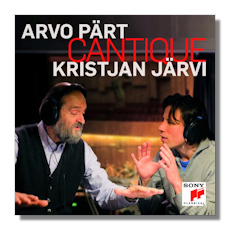
The Internet's Premier Classical Music Source
Related Links
- Pärt Reviews
- Latest Reviews
- More Reviews
-
By Composer
-
Collections
DVD & Blu-ray
Books
Concert Reviews
Articles/Interviews
Software
Audio
Search Amazon
Recommended Links
Site News
 SACD Review
SACD Review
Arvo Pärt

Cantique
- Stabat Mater for Choir & String Orchestra (27:59)
- Symphony #3 (24:01)
- Cantique des degrès for Choir & Orchestra (7:47)
RIAS Kammerchor
Berlin Radio Symphony/Kristjan Järvi
Sony 88697-75391-2 Hybrid Multichannel SACD
The title of this release is Cantique, but Stabat Mater, originally for two high voices and string trio but revised in 2008 on a commission suggested by Kristjan Järvi, is the more significant of the vocal works on this release. Both are première recordings. Pärt's Symphony #3 has previously been recorded twice by Neeme Järvi, to whom the work is dedicated, and also by Paavo Järvi, among others. It is one of this prolific composer's most popular works.
Stabat Mater is a lament, originally in the form of a medieval hymn, the words of which concern Mary the mother of Jesus at the crucifixion. The words have previously been set by Palestrina, Vivaldi, Pergolesi, Rossini and Dvořák. The text is not included with this release and is not of primary interest here in any case. Part's original commission was from the Alban Berg Foundation. The music is beautiful, with lovely singing and fine instrumental playing. Only high voices (sopranos, altos and tenors) are heard; the choir includes no basses. When the choir enters, after a substantial instrumental beginning, the high voices emerge gently from the sound of the higher strings. Most of the music is quiet and gentle, though the choir is in full voice briefly after about five minutes. At no point is there anything like an outcry, though we do hear some emphatic low basses at one point. However, Pärt surprises us, after a third of the way through, with a lively dance-like passage, which separates sections of the hymn, and he does this twice more later. The ending is peaceful.
Cantigue des degres is for full mixed choir and orchestra. The work was commissioned by Princess Caroline of Monaco for the 50th anniversary of her father's reign. The text is the psalm which begins "I will lift up mine eyes unto the hills." The choir is heard immediately, along with the light sound of bells and a horn. Dyamics are much wider than in the Stabat Mater. Both choir and orchestra are much more forceful, though much of the singing is gentle. Brass and drums are heard, and the ending is solemn.
In his notes, Guido Johannes Joerg calls Pärt's Symphony #3 a major symphonic masterpiece and I would not disagree. Fresh and exciting, it is a sound world apart from his earlier symphonies, which were serialist. It has been called a transitional work in the history of Pärt's styles, if only because between 1968 and 1976, while the composer was studying chant and polyphony, he released – in 1971 – only this work; the next was to be the vastly different Für Alina. I don't really accept the designation of transitional because I don't hear it as blending the extremes these styles represent. Rather, it returns to something like the mainstream of northern and eastern European music. It is melodic and often hushed. It has reminded some of Sibelius or Shostakovich and there is one bit that even reminded me of the Russian Easter Overture, but it would be a mistake to call it derivative. This is Pärt's voice.
The three movements of the symphony are designated only by numbers. The first begins with a clear simple theme which eventually moves from high to low voices. The mood becomes solemn, even portentous, and is emphasized with brass and drums. The middle movement begins pleasantly and harmoniously with more lightly scored forces, mostly strings. It builds to a climax; solemn brass and a fast passage for strings yield to a quiet mysterious section with a quiet piccolo and tinkling sounds. After a pause, high strings and a high, slow trumpet solo precedes heavier string playing leading into a spectacular final passage for rolling drums which die off by the end of the movement. The movements are played without pause and the final one rises to the level of sublimity, with solemn brass accompanied by pizzicato lower strings. The end is brief but forceful.
For the choral works there is no basis for comparison with any other performances. There are some notable differences between this recording of the symphony and the 1992 BIS recording by the work's dedicatee, Neeme Järvi. For one thing there is an almost three minutes difference in the duration of the middle movement. Kristjan takes it much slower than does his father, and the hushed passages may benefit from this, for some ears. Kristjan's performance is generally gentler also. But particularly in that middle movement, Neeme gives the music a firm flow and this becomes more forceful as it leads to the climax. Also, on the BIS recording one can clearly hear two melodies in counterpoint. This may be partly the power of that recording, which is outstandingly good, but on the Sony recording, although it is possible to hear a countermelody, one line is either dominant or else two lines seem almost to blend. (I do need to mention that I have heard only the CD, not the SACD version.) The orchestral timbres seems blended in Kristjan's orchestra also, but this may be taken as a credit to Pärt's orchestration. In any case, this work sounds wonderful on both releases.
Recommended, particularly for the Stabat Mater.
Copyright © 2010, R. James Tobin





















